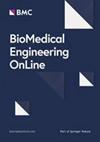Muscle synergy and kinematic synergy analyses during sit-to-stand motions in hallux valgus patients before and after treatment with Kinesio taping
IF 2.9
4区 医学
Q3 ENGINEERING, BIOMEDICAL
引用次数: 0
Abstract
To explore the impact of hallux valgus (HV) on lower limb neuromuscular control strategies during the sit-to-stand (STS) movement, and to evaluate the effects of Kinesio taping (KT) intervention on these control strategies in HV patients. We included 14 young healthy controls (HY), 13 patients in the HV group (HV), and 11 patients in the HV group (HVI) who underwent a Kinesio taping (KT) intervention during sit-to-stand (STS) motions. We extracted muscle and kinematic synergies from EMG and motion capture data using non-negative matrix factorization (NNMF). In addition, we calculated the center of pressure (COP) and ground reaction forces (GRF) to assess balance performance. There were no significant differences in the numbers of muscle and kinematic synergies between groups. In the HV group, knee flexors and ankle plantar flexors were abnormally activated, and muscle synergy D was differentiated. Muscle synergy D was not differentiated in the HVI group. Abnormal activation of knee flexors and plantar flexors led to the differentiation of module D in HV patients, which can be used as an indicator of the progress of HV rehabilitation. KT intervention improved motor control mechanisms in HV patients.在使用 Kinesio 胶带治疗前后,对拇后翻患者坐立运动过程中的肌肉协同作用和运动协同作用进行分析
目的:探讨在从坐到站(STS)运动中,足外翻(HV)对下肢神经肌肉控制策略的影响,并评估 Kinesio 胶带(KT)干预对 HV 患者这些控制策略的影响。我们纳入了 14 名年轻的健康对照组(HY)、13 名 HV 组(HV)患者和 11 名 HVI 组(HVI)患者,他们都在坐立(STS)运动中接受了 Kinesio 胶带(KT)干预。我们使用非负矩阵因式分解法(NNMF)从肌电图和运动捕捉数据中提取了肌肉和运动协同作用。此外,我们还计算了压力中心(COP)和地面反作用力(GRF),以评估平衡能力。各组之间在肌肉数量和运动协同方面没有明显差异。在 HV 组中,膝关节屈肌和踝关节跖屈肌异常激活,肌肉协同作用 D 有所差异。在 HVI 组中,肌肉协同作用 D 没有分化。膝关节屈肌和踝关节跖屈肌的异常激活导致 HV 患者的模块 D 分化,这可作为 HV 康复进展的一个指标。KT干预改善了高位截瘫患者的运动控制机制。
本文章由计算机程序翻译,如有差异,请以英文原文为准。
求助全文
约1分钟内获得全文
求助全文
来源期刊

BioMedical Engineering OnLine
工程技术-工程:生物医学
CiteScore
6.70
自引率
2.60%
发文量
79
审稿时长
1 months
期刊介绍:
BioMedical Engineering OnLine is an open access, peer-reviewed journal that is dedicated to publishing research in all areas of biomedical engineering.
BioMedical Engineering OnLine is aimed at readers and authors throughout the world, with an interest in using tools of the physical and data sciences and techniques in engineering to understand and solve problems in the biological and medical sciences. Topical areas include, but are not limited to:
Bioinformatics-
Bioinstrumentation-
Biomechanics-
Biomedical Devices & Instrumentation-
Biomedical Signal Processing-
Healthcare Information Systems-
Human Dynamics-
Neural Engineering-
Rehabilitation Engineering-
Biomaterials-
Biomedical Imaging & Image Processing-
BioMEMS and On-Chip Devices-
Bio-Micro/Nano Technologies-
Biomolecular Engineering-
Biosensors-
Cardiovascular Systems Engineering-
Cellular Engineering-
Clinical Engineering-
Computational Biology-
Drug Delivery Technologies-
Modeling Methodologies-
Nanomaterials and Nanotechnology in Biomedicine-
Respiratory Systems Engineering-
Robotics in Medicine-
Systems and Synthetic Biology-
Systems Biology-
Telemedicine/Smartphone Applications in Medicine-
Therapeutic Systems, Devices and Technologies-
Tissue Engineering
 求助内容:
求助内容: 应助结果提醒方式:
应助结果提醒方式:


